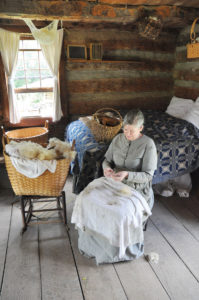Time Machine
7/31/2019Interpreting history while living history and volunteering at Living History Farms.

Barb Raife volunteers at Living
History Farms each Thursday.
She has been involved there for
40 years in a variety of roles. She currently labors on the 1850 Farm.
“Well, this is as close as I’m ever going to get to a time machine,” says Barb Raife, an interpreter at Living History Farms. “It’s my way to travel back in time.”
Living history can be a good way to learn history. Raife began by working at the 1900 Farm after she saw an ad in the newspaper in 1979, and she thought it sounded fun. She later went back in time to work at the 1850 Farm, and that is where she volunteers now — one day per week on Thursdays.
“My association with the farm goes back about 40 years, off and on, very intermittently,” she says. “I’ve just always been really interested in, how did people live? Whether it’s a castle or a manor house in England or a stone cottage in Ireland or a thatched hut in Ireland. How did they live? What did they eat? I always want to see the kitchen. I learn something every time I come back. Sometimes it’s from staff. Sometimes it’s from visitors or even little kids.”
Interpreters dress in period clothing and portray for guests what daily life would have been like during various time periods on Midwestern U.S. farms. Daily chores begin with building a fire, bringing in water, making up the bed and shooing away mice.
“Next it is figuring out what we’re going to cook and get that stuff going,” she says. “If we’re going to bake, we need a lot of coals, so we have to build up a pretty good fire and keep that tended all morning.”
The interpreters prepare meals that would have been produced by a family in 1850. Cooking meals generally takes most of a given day. Add in gardening, working wool to prepare for spinning, cleaning the cabin and tending to the animals, and a day on the 1850 Farm can leave one tired.
“Tired,” Raife says. “But a good kind of tired.”
Most women during the period wore full-length dresses with long sleeves in both the winter and summer months. No shorts or short sleeves, partly for cultural modesty, but also for practical reasons.
“The answer is yes,” says Raife. “(It does get hot), but this is my sunscreen. This is my insect repellent. If you’re going to go pick raspberries, I can just go right in there and get wherever I want to.”
Living history is a labor of love for Raife, and after 40 years, she has a lot of fond memories.
“I think the best moment is usually around the dinner table,” she says, referring to the daily meal the workers share after working hard to prepare it.
“Because we usually have something really good to eat, and you don’t stick around out here if you don’t have some things in common. So the kind of people that tend to be out here, you just always have something to talk about.”
Still, if Raife had an actual time machine and was given the option, she wouldn’t trade 21st-century life for the 1850s, mostly for the lack of modern medicine.
“I wouldn’t have a tooth in my head if I was born in 1850,” she laughs. “If I lived to this age, I would not have any teeth, and I’ve had Lasik eye surgery because I was so nearsighted. So I wouldn’t be able to see to do anything.”
Living History Farms is a 500-acre outdoor museum located in Urbandale at 11121 Hickman Road. For more information, call 515-278-5286 or visit www.lhf.org. ♦




















